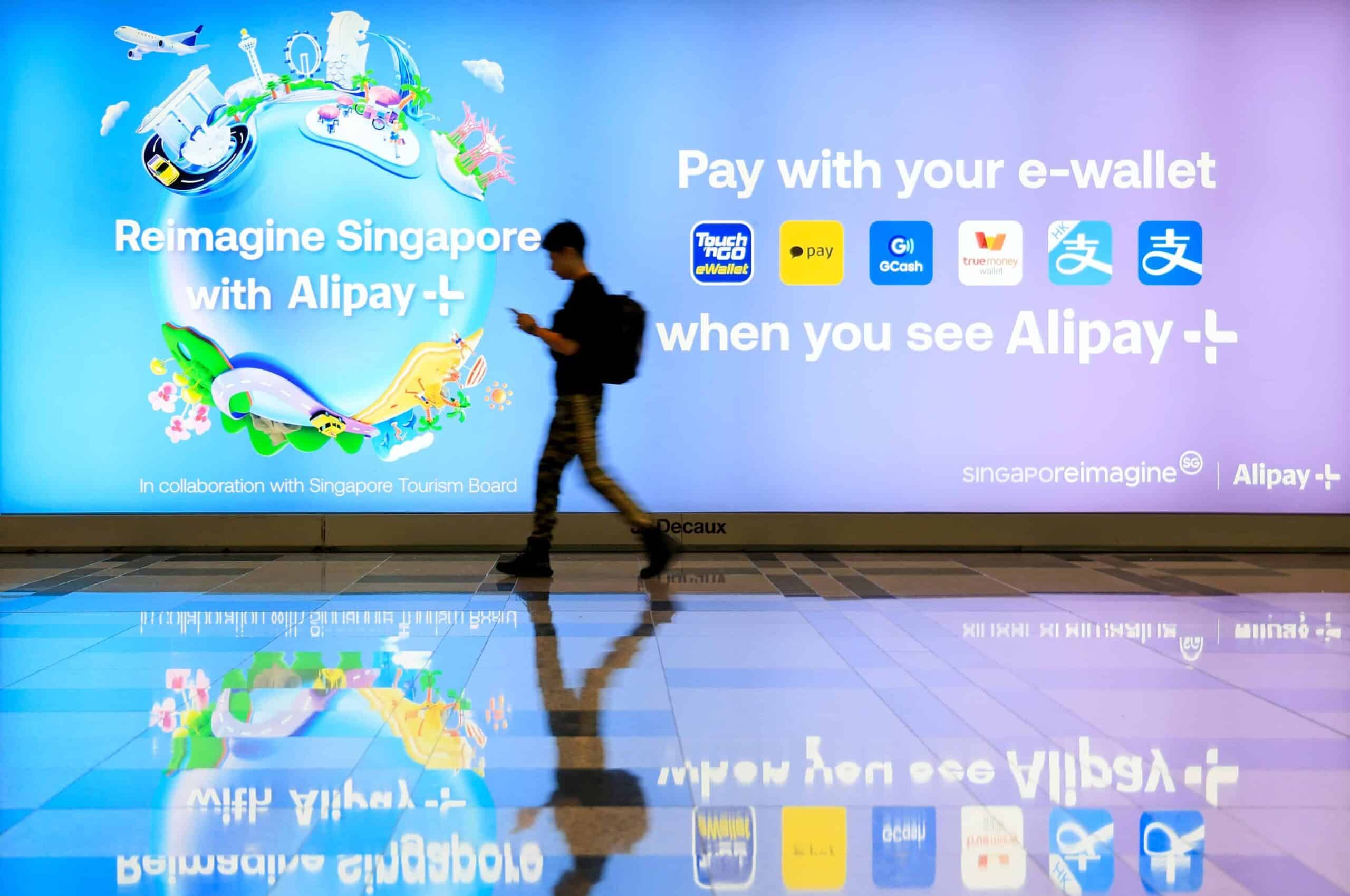
On social media platform Xiaohongshu, Chinese tourists arriving in Japan for the first time since the pandemic have recently been marveling at the dozens of digital wallets and mobile payment services available in a country where cash, until recently, was king.
Now Chinese fintech giant Ant Group is making a renewed effort to unite the fragmented market by integrating these different digital wallets, and others across the region, onto one platform — Alipay+, which it first launched in 2020.
Alipay led China’s cashless revolution and, together with Tencent’s WeChat Pay, still holds a 90 percent share of the market. Ant, an affiliate of Alibaba, has attempted to replicate that success abroad for over a decade, raising billions to fund its overseas expansion and investing in e-wallets across Southeast Asia, such as Paytm in India and Dana in Indonesia.
A company like Ant with that much money and capital invested in it can’t sit still and has to keep on expanding however it can.
Zennon Kapron, founder of the consultancy Kapronasia
But the drive lost momentum after Beijing dramatically suspended Ant Group’s blockbuster initial public offering in 2020.
With a $977 million fine last July marking the end of China’s regulatory crackdown on Ant, the company is now reinvigorating its efforts abroad. In an internal letter seen by Chinese outlet Caixin last month, the company said it will break off its non-core operations into independent units — including Ant International, which it hopes will give renewed focus to its overseas businesses.

The overhaul comes after a long period of change at Ant, which included Alibaba founder Jack Ma ceding control of the business. Ant is hoping the reorganization will allow it to get back into Chinese regulators’ good graces and eventually help revive its IPO plans.
Given ongoing regulatory curbs and falling profits at home, looking abroad is Ant’s best option to prove to investors it has a convincing growth plan. Questions remain, however, over just how profitable Alipay+ will prove, and whether it will gain widespread acceptance outside China.
“A company like Ant with that much money and capital invested in it can’t sit still and has to keep on expanding however it can. And at the moment, doing that internationally is probably easier than doing it domestically,” says Zennon Kapron, founder of the consultancy Kapronasia.
Ant’s earlier efforts in overseas markets were stymied in part because the uptake of mobile payments across its main target region, Southeast Asia, was relatively low.
The company’s acquisition strategy has had mixed success. Ant reduced holdings in less promising ventures such as South Korea’s Kakao Pay in 2022 and India’s Paytm last year. But Mynt, in which it owns a 40 percent stake, became Philippines’ first unicorn in 2021 when its mobile payment app GCash took off.

Adoption of cashless payments accelerated during the pandemic across the region, as consumers switched from cash to contactless methods. Yet homegrown alternatives to Alipay have meantime developed in several markets, such as Indonesia’s Doku and Malaysia’s GrabPay.
To avoid competing with them, the idea behind Alipay+ is that it will serve as a cross-border payment platform to connect existing wallets, integrating over 25 digital payment services providers across mostly Asian countries and making them interoperable.
China had a massive opportunity pre-Covid when Alipay and WeChat Pay took off to compete and potentially displace outdated Western payment systems… that initial window of competition has largely closed.
Aaron Klein, a senior fellow at the Brookings Institution
For instance, starting in February, thousands of 7-Elevens across Thailand have accepted payments from 13 wallets — from South Korea’s Naver Pay and Toss Pay to Mongolia’s Hipay — via Alipay+. In January, the company reported that over 88 million merchants across 57 markets have adopted it as well, including hotels, airport retailers and most recently, AirAsia.
“It is providing backend services that digital wallets in Singapore, Pakistan, and the Philippines could use to extend their own services into other markets,” says Jeffrey Towson, a tech consultant focused on China. In doing so, Alipay+ is targeting not just tourists from China, but also those traveling and sending money across Asia.

“If Alipay can create that network on the backend, kind of like a SWIFT network [a messaging network used by financial institutions to process international money transfers], there’s a big value proposition with that,” says Kapron. “The narrow, strategic focus on strictly cross-border payments should pay dividends in the long run for the international business.”
Cross-border payments are certainly a large market, with global flows expected to reach $250 trillion by 2027, according to a recent report by Citigroup, driven by growing international trade and e-commerce, and lengthening supply chains. The revenue pie for service providers has already reached $200 billion annually, it estimates.
The question is how much of that pie will Alipay+ be able to seize. Singapore-based Nium and Thunes are already competing with it in providing infrastructure for cross-border payments. The cut it can take from each transaction is also likely tiny. While financial institutions could earn around 5 to 7 percent per cross-border transaction a decade ago, the fees are now in a race towards zero, Kapron says. The transfer fees charged by mobile operators are around 1.5 – 2 percent, according to the database Remittances Prices Worldwide.
“Because there’s been so much competition in this space, those fees are compressing very rapidly,” Kapron says. “It becomes a game of volumes.”

While Ant often highlights of Alipay+’s expanding reach and new deals with retailers, it has been far less forthcoming about how profitable the venture is and how much money it is moving around. When the company last disclosed such data, in its 2020 IPO prospectus, the total payment volume of international transactions it handled in the prior year was 622 billion yuan ($86 billion), a sliver of the 118 trillion yuan ($16.3 trillion) transacted on Alipay domestically.

Ant Group did not respond to a request for comment.
Another unknown is how many consumers across Asia will use the Chinese platform regularly.
“If they want to go long term in their business development, they need to really push to get breakthroughs in the local market,” says Chris Pereira, founder of consultancy iMpact and a former public relations executive at Huawei. “And that’s only done through trust.”
Ant Group executives have at least been clear that Alipay+ is a departure from the one-stop platform Alipay is known for in China, where users can hail a cab, settle their utility bills and buy flight tickets all on its app.
“While many of you are familiar with the success of Alipay in China, Alipay+ is not another superapp we are launching globally,” Angel Zhao, then the president of international business at Ant Group, stressed at the Singapore Fintech Festival in 2022.
Markets beyond Southeast Asia seem further out of reach. While QR code payment has yet to take hold in Western countries, Apple Pay and advances in contactless transactions have improved payment systems. With its thin profit margins, the Ant Group also won’t be able to offer the same rebates and other incentives that keep consumers loyal to their credit cards, says Aaron Klein, a senior fellow at the Brookings Institution.
“China had a massive opportunity pre-Covid when Alipay and WeChat Pay took off to compete and potentially displace outdated Western payment systems,” says Klein. “In the post Covid world, that initial window of competition has largely closed.”
Concerns over data security and cybersecurity pose another big potential problem for Ant, particularly in non-Asian markets.
“Like telecommunications, the payment services industry is at the center of the geopolitical storm because it has to do with where money is going,” says Pereira.
Ant has tried to stay one step ahead by spinning off its international business and moving it to Singapore. Such moves are a step in the right direction, Pereira says, but it is unclear if that will be sufficient to alleviate concerns.
“How America is reacting to TikTok is illustrative of how it would react if China were to attempt to push Alipay and WeChat Pay as more significant competitors to Visa and MasterCard,” Brookings’s Klein says.

Rachel Cheung is a staff writer for The Wire China based in Hong Kong. She previously worked at VICE World News and South China Morning Post, where she won a SOPA Award for Excellence in Arts and Culture Reporting. Her work has appeared in The Washington Post, Los Angeles Times, Columbia Journalism Review and The Atlantic, among other outlets.




